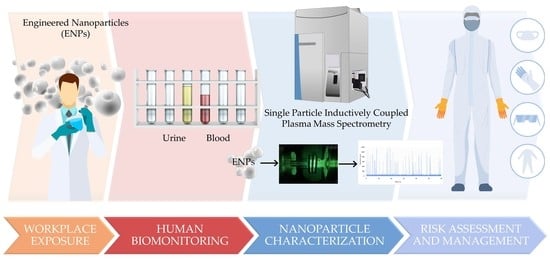Occupational Exposure to Metal Engineered Nanoparticles: A Human Biomonitoring Pilot Study Involving Italian Nanomaterial Workers
Abstract
1. Introduction
2. Materials and Methods
2.1. Population Recruitment, Biological Samples Collection and Preparation
2.2. Certified NPs Reference Standards
2.3. SP-ICP-MS Analysis of NPs
2.4. Method Validation
3. Results
3.1. Investigated Population
3.2. SP-ICP-MS Method Validation Performances in Urine and Blood
3.3. Size and Concentration of Metal NPs in Urine and Blood
4. Discussion
5. Conclusions
Author Contributions
Funding
Institutional Review Board Statement
Informed Consent Statement
Data Availability Statement
Conflicts of Interest
References
- NIOSH (National Institute for Occupational Safety and Health). Protecting the Nanotechnology Workforce: NIOSH Nanotechnology Research and Guidance Strategic Plan, 2013–2016; NIOSH: Cincinnati, OH, USA, 2014.
- Schulte, P.; Leso, V.; Niang, M.; Iavicoli, I. Biological Monitoring of Workers Exposed to Engineered Nanomaterials. Toxicol. Lett. 2018, 298, 112–124. [Google Scholar] [CrossRef] [PubMed]
- Madhwani, K. Safe Development of Nanotechnology: A Global Challenge. Indian. J. Occup. Environ. Med. 2013, 17, 87–88. [Google Scholar] [CrossRef] [PubMed]
- Leso, V.; Fontana, L.; Mauriello, M.; Iavicoli, I. Occupational Risk Assessment of Engineered Nanomaterials: Limits, Challenges and Opportunities. Curr. Nanosci. 2016, 13, 55–78. [Google Scholar] [CrossRef]
- Lee, J.H.; Mun, J.; Park, J.D.; Yu, I.J. A Health Surveillance Case Study on Workers Who Manufacture Silver Nanomaterials. Nanotoxicology 2012, 6, 667–669. [Google Scholar] [CrossRef] [PubMed]
- Liu, H.-H.; Chen, C.-Y.; Chen, G.-I.; Lee, L.-H.; Chen, H.-L. Relationship between Indium Exposure and Oxidative Damage in Workers in Indium Tin Oxide Production Plants. Int. Arch. Occup. Environ. Health 2012, 85, 447–453. [Google Scholar] [CrossRef]
- Pelclova, D.; Barosova, H.; Kukutschova, J.; Zdimal, V.; Navratil, T.; Fenclova, Z.; Vlckova, S.; Schwarz, J.; Zikova, N.; Kacer, P.; et al. Raman Microspectroscopy of Exhaled Breath Condensate and Urine in Workers Exposed to Fine and Nano TiO2 Particles: A Cross-Sectional Study. J. Breath Res. 2015, 9, 036008. [Google Scholar] [CrossRef]
- Marie-Desvergne, C.; Dubosson, M.; Touri, L.; Zimmermann, E.; Gaude-Môme, M.; Leclerc, L.; Durand, C.; Klerlein, M.; Molinari, N.; Vachier, I.; et al. Assessment of Nanoparticles and Metal Exposure of Airport Workers Using Exhaled Breath Condensate. J. Breath Res. 2016, 10, 036006. [Google Scholar] [CrossRef]
- Bocca, B.; Leso, V.; Battistini, B.; Caimi, S.; Senofonte, M.; Fedele, M.; Cavallo, D.M.; Cattaneo, A.; Lovreglio, P.; Iavicoli, I. Human Biomonitoring and Personal Air Monitoring. An Integrated Approach to Assess Exposure of Stainless-Steel Welders to Metal-Oxide Nanoparticles. Environ. Res. 2023, 216, 114736. [Google Scholar] [CrossRef]
- Bocca, B.; Battistini, B.; Petrucci, F. Silver and Gold Nanoparticles Characterization by SP-ICP-MS and AF4-FFF-MALS-UV-ICP-MS in Human Samples Used for Biomonitoring. Talanta 2020, 220, 121404. [Google Scholar] [CrossRef]
- Battistini, B.; Petrucci, F.; De Angelis, I.; Failla, C.M.; Bocca, B. Quantitative Analysis of Metals and Metal-Based Nano- and Submicron-Particles in Tattoo Inks. Chemosphere 2020, 245, 125667. [Google Scholar] [CrossRef]
- Bocca, B.; Caimi, S.; Senofonte, O.; Alimonti, A.; Petrucci, F. ICP-MS Based Methods to Characterize Nanoparticles of TiO2 and ZnO in Sunscreens with Focus on Regulatory and Safety Issues. Sci. Total Environ. 2018, 630, 922–930. [Google Scholar] [CrossRef]
- Bocca, B.; Sabbioni, E.; Mičetić, I.; Alimonti, A.; Petrucci, F. Size and Metal Composition Characterization of Nano- and Microparticles in Tattoo Inks by a Combination of Analytical Techniques. J. Anal. At. Spectrom. 2017, 32, 616–628. [Google Scholar] [CrossRef]
- ISO/IEC 17025:2017; General Requirements for the Competence of Testing and Calibration Laboratories. International Organization for Standardization: London, UK, 2017.
- Doak, S.H.; Liu, Y.; Chen, C. Genotoxicity and Cancer. In Adverse Effects of Engineered Nanomaterials; Elsevier: Amsterdam, The Netherlands, 2012; pp. 243–261. [Google Scholar] [CrossRef]
- Istiqola, A.; Syafiuddin, A. A Review of Silver Nanoparticles in Food Packaging Technologies: Regulation, Methods, Properties, Migration, and Future Challenges. J. Chin. Chem. Soc. 2020, 67, 1942–1956. [Google Scholar] [CrossRef]
- Lischkova, L.; Pelclova, D.; Hlusicka, J.; Navratil, T.; Vlckova, S.; Fenclova, Z.; Dvorackova, S.; Popov, A.; Michalcova, A.; Marek, I.; et al. Detection and identification of engineered nanoparticles in exhaled breath condensate, blood serum, and urine of occupationally exposed subjects. Monatsh. Chem. 2019, 150, 511–523. [Google Scholar] [CrossRef]
- Narciso, L.; Coppola, L.; Lori, G.; Andreoli, C.; Zjino, A.; Bocca, B.; Petrucci, F.; Di Virgilio, A.; Martinelli, A.; Tinari, A.; et al. Genotoxicity, Biodistribution and Toxic Effects of Silver Nanoparticles after In Vivo Acute Oral Administration. NanoImpact 2020, 18, 100221. [Google Scholar] [CrossRef]
- Boudreau, M.D.; Imam, M.S.; Paredes, A.M.; Bryant, M.S.; Cunningham, C.K.; Felton, R.P.; Jones, M.Y.; Davis, K.J.; Olson, G.R. Differential Effects of Silver Nanoparticles and Silver Ions on Tissue Accumulation, Distribution, and Toxicity in the Sprague Dawley Rat Following Daily Oral Gavage Administration for 13 Weeks. Toxicol. Sci. 2016, 150, 131–160. [Google Scholar] [CrossRef]
- Iavicoli, I.; Fontana, L.; Nordberg, G. The effects of nanoparticles on the renal system. Crit. Rev. Toxicol. 2016, 46, 490–560. [Google Scholar] [CrossRef]
- Friedman, N.; Dagan, A.; Elia, J.; Merims, S.; Benny, O. Physical Properties of Gold Nanoparticles Affect Skin Penetration via Hair Follicles. Nanomed. Nanotechnol. Biol. Med. 2021, 36, 102414. [Google Scholar] [CrossRef]
- Weir, A.; Westerhoff, P.; Fabricius, L.; Hristovski, K.; von Goetz, N. Titanium Dioxide Nanoparticles in Food and Personal Care Products. Environ. Sci. Technol. 2012, 46, 2242–2250. [Google Scholar] [CrossRef]
- Pelclova, D.; Navratil, T.; Kacerova, T.; Zamostna, B.; Fenclova, Z.; Vlckova, S.; Kacer, P. NanoTiO2 Sunscreen Does Not Prevent Systemic Oxidative Stress Caused by UV Radiation and a Minor Amount of NanoTiO2 Is Absorbed in Humans. Nanomaterials 2019, 9, 888. [Google Scholar] [CrossRef]
- Peters, R.J.B.; Oomen, A.G.; van Bemmel, G.; van Vliet, L.; Undas, A.K.; Munniks, S.; Bleys, R.L.A.W.; Tromp, P.C.; Brand, W.; van der Lee, M. Silicon Dioxide and Titanium Dioxide Particles Found in Human Tissues. Nanotoxicology 2020, 14, 420–432. [Google Scholar] [CrossRef] [PubMed]
- Heringa, M.B.; Peters, R.J.B.; Bleys, R.L.A.W.; van der Lee, M.K.; Tromp, P.C.; van Kesteren, P.C.E.; van Eijkeren, J.C.H.; Undas, A.K.; Oomen, A.G.; Bouwmeester, H. Detection of Titanium Particles in Human Liver and Spleen and Possible Health Implications. Part. Fibre Toxicol. 2018, 15, 15. [Google Scholar] [CrossRef] [PubMed]
- Methner, M.M. Effectiveness of a Custom-Fitted Flange and Local Exhaust Ventilation (LEV) System in Controlling the Release of Nanoscale Metal Oxide Particulates During Reactor Cleanout Operations. Int. J. Occup. Environ. Health 2010, 16, 475–487. [Google Scholar] [CrossRef] [PubMed]
- Mapanao, A.K.; Giannone, G.; Summa, M.; Ermini, M.L.; Zamborlin, A.; Santi, M.; Cassano, D.; Bertorelli, R.; Voliani, V. Biokinetics and Clearance of Inhaled Gold Ultrasmall-in-Nano Architectures. Nanoscale Adv. 2020, 2, 3815–3820. [Google Scholar] [CrossRef] [PubMed]
- Kreyling, W.G.; Holzwarth, U.; Schleh, C.; Hirn, S.; Wenk, A.; Schäffler, M.; Haberl, N.; Semmler-Behnke, M.; Gibson, N. Quantitative Biokinetics over a 28 Day Period of Freshly Generated, Pristine, 20 Nm Titanium Dioxide Nanoparticle Aerosols in Healthy Adult Rats after a Single Two-Hour Inhalation Exposure. Part. Fibre Toxicol. 2019, 16, 29. [Google Scholar] [CrossRef]
- Wu, W.-T.; Li, L.-A.; Tsou, T.-C.; Wang, S.-L.; Lee, H.-L.; Shih, T.-S.; Liou, S.-H. Longitudinal follow-up of health effects among workers handling engineered nanomaterials: A panel study. Environ. Health 2019, 18, 107. [Google Scholar] [CrossRef]
- Pelclova, D.; Zdimal, V.; Komarc, M.; Schwarz, J.; Ondracek, J.; Ondrackova, L.; Kostejn, M.; Vlckova, S.; Fenclova, Z.; Dvorackova, S.; et al. Three-Year Study of Markers of Oxidative Stress in Exhaled Breath Condensate in Workers Producing Nanocomposites, Extended by Plasma and Urine Analysis in Last Two Years. Nanomaterials 2020, 10, 2440. [Google Scholar] [CrossRef]
- Liou, S.-H.; Wu, W.-T.; Liao, H.-Y.; Chen, C.-Y.; Tsai, C.-Y.; Jung, W.-T.; Lee, H.-L. Global DNA methylation and oxidative stress biomarkers in workers exposed to metal oxide nanoparticles. J. Hazard. Mater. 2017, 331, 329–335. [Google Scholar] [CrossRef]
- Schulte, P.A.; Leso, V.; Niang, M.; Iavicoli, I. Current state of knowledge on the health effects of engineered nanomaterials in workers: A systematic review of human studies and epidemiological investigations. Scand. J. Work. Environ. Health 2019, 45, 217–238. [Google Scholar] [CrossRef]
- World Health Organization. WHO Guidelines on Protecting Workers from Potential Risks of Manufactured Nanomaterials; World Health Organization: Geneva, Switzerland, 2017. [Google Scholar]
- NIOSH (National Institute for Occupational Safety and Health). Occupational Exposure to Titanium Dioxide; Current Intelligence Bulletin 63; NIOSH: Cincinnati, OH, USA, 2011.
- Laux, P.; Riebeling, C.; Booth, A.M.; Brain, J.D.; Brunner, J.; Cerrillo, C.; Creutzenberg, O.; Estrela-Lopis, I.; Gebel, T.; Johanson, G.; et al. Biokinetics of Nanomaterials: The Role of Biopersistence. NanoImpact 2017, 6, 69–80. [Google Scholar] [CrossRef]


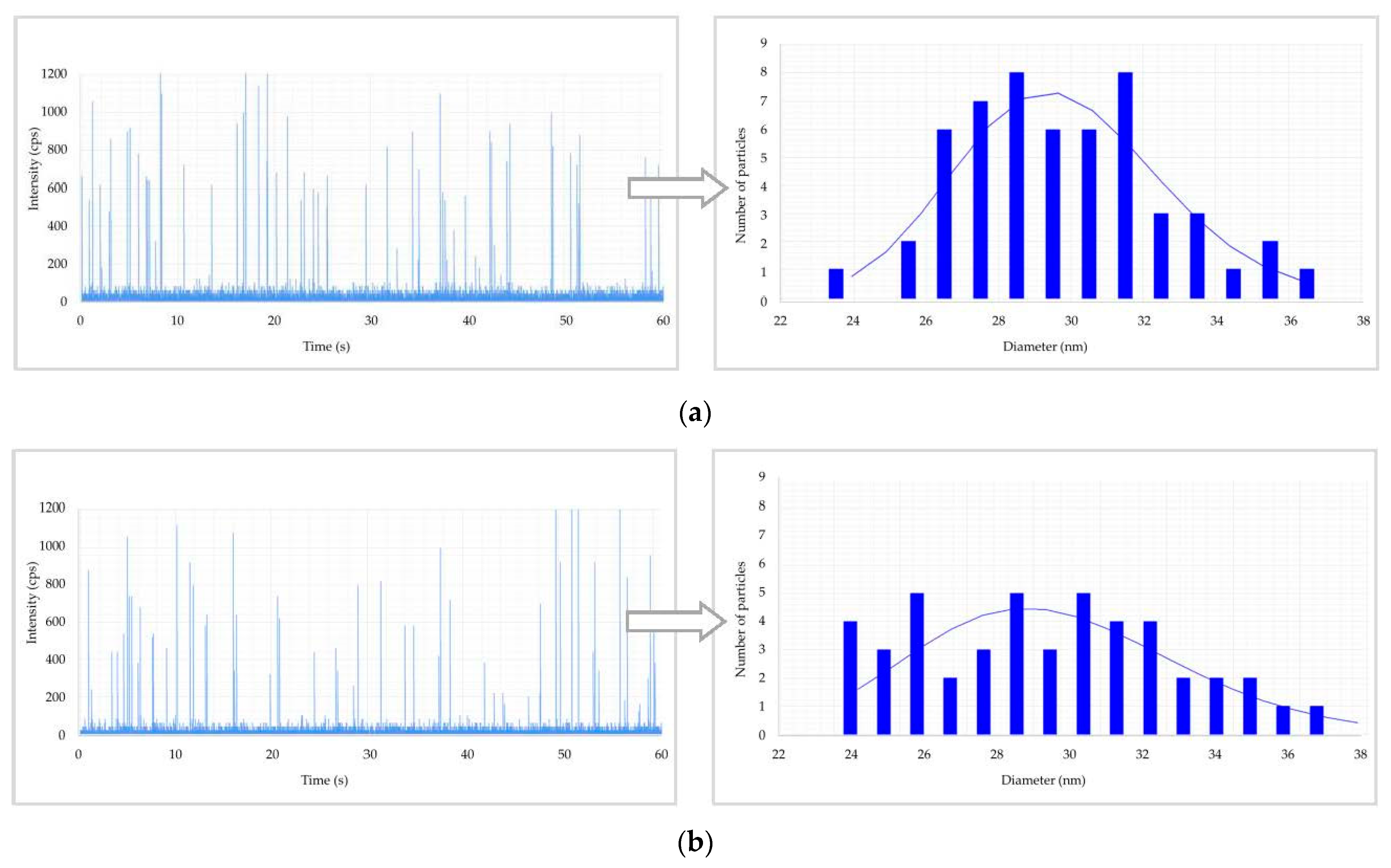
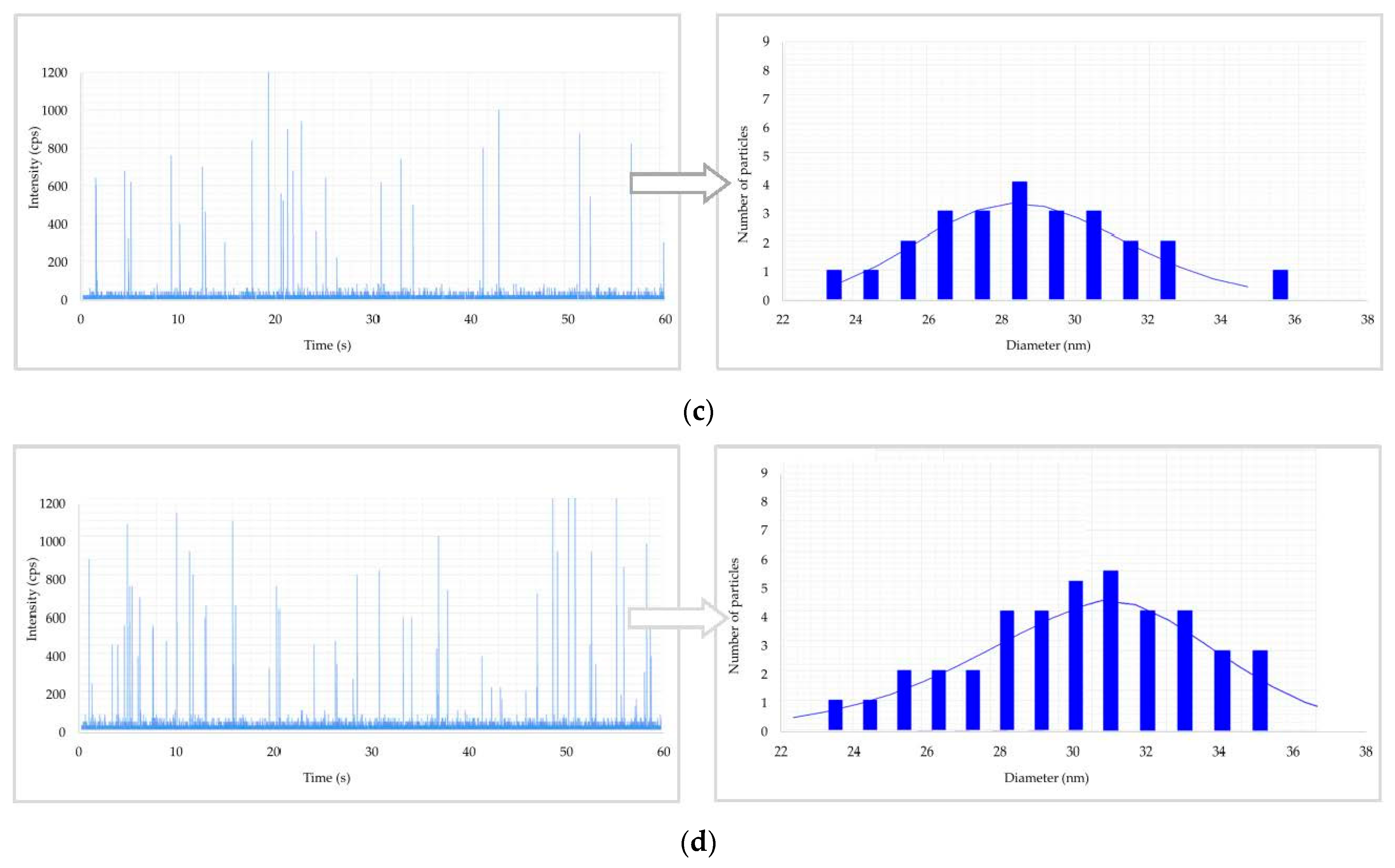
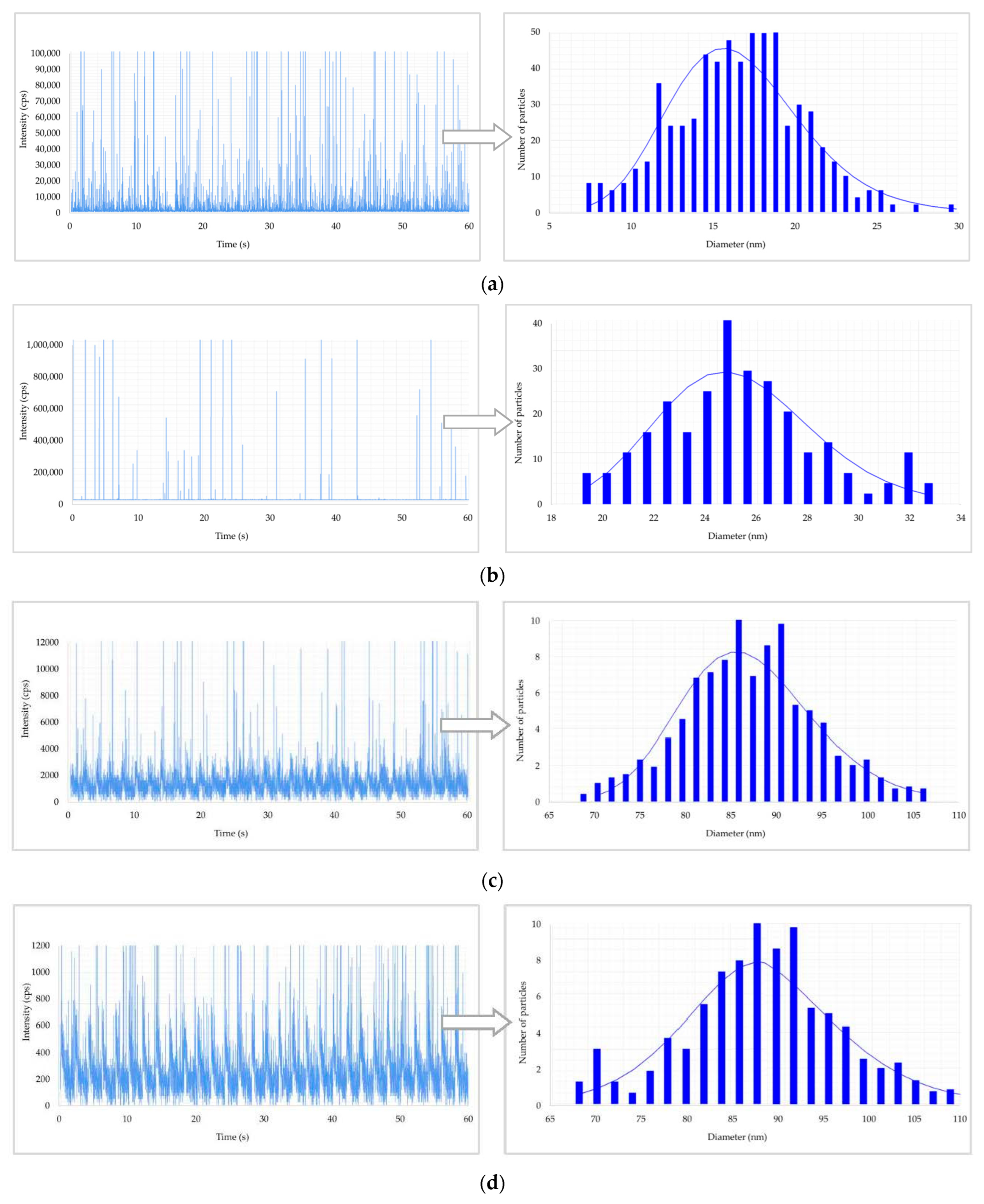
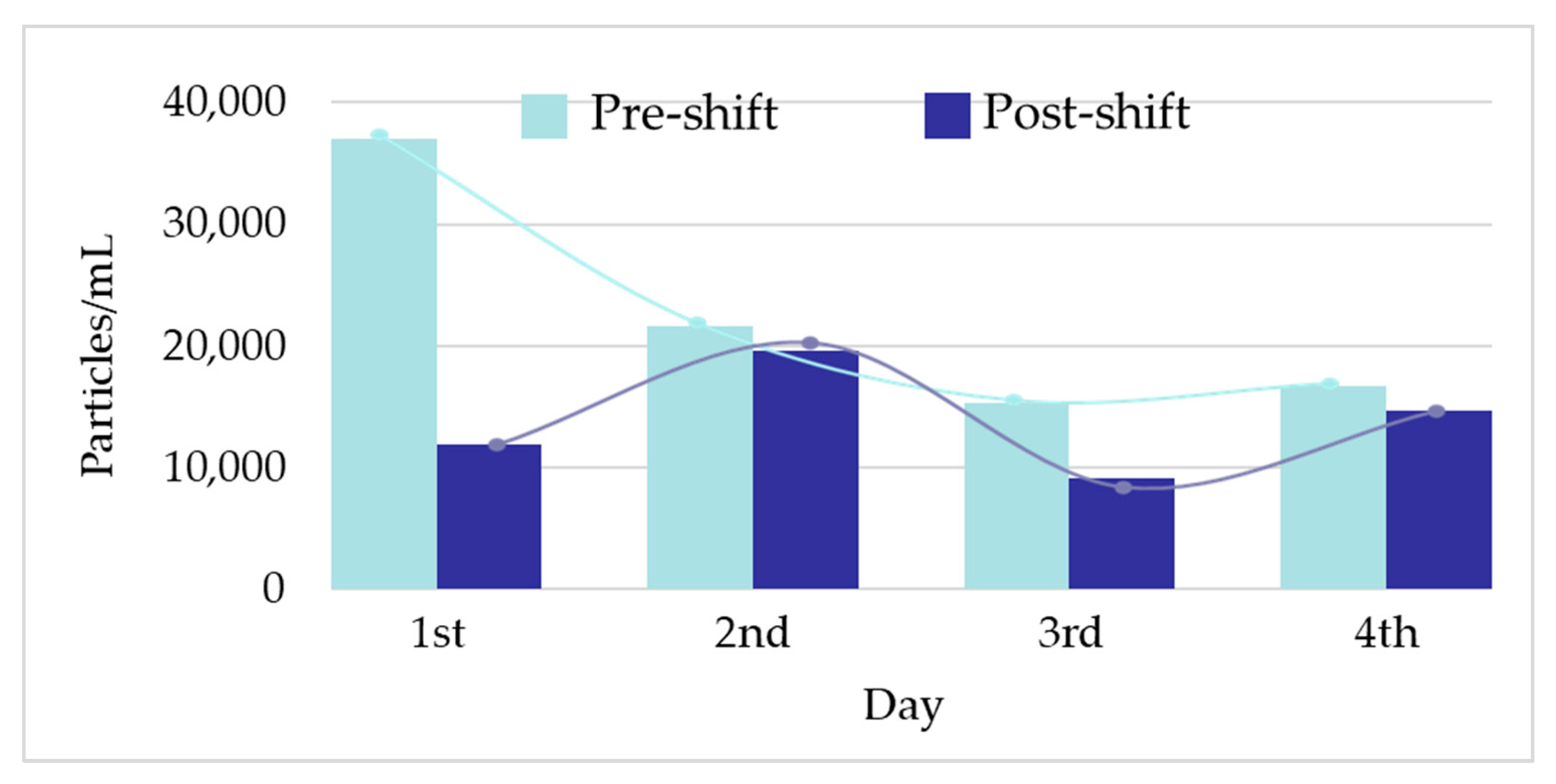

| Instrument | ICAP-Q (Thermo Fisher) |
|---|---|
| Nebulizer | Quartz concentric |
| Spray chamber | Quartz cyclonic |
| RF power (W) | 1400 |
| Nebulizer gas flow (L/min) | 1.02–1.06 |
| Isotopes | 107Ag, 197Au, 115In, 192Ir, 106Pd, 195Pt, 47Ti |
| Sample uptake rate (mL/min) | 0.30 |
| Acquisition mode, time (s) | Q-Cell in KED (4.8 mL/min He), 60 |
| Transport efficiency (%) | 4.5 |
| Dwell time (msec) | 5 |
| Density (g/cm3) | Au, 19.3; Ag, 10.5; In2O3, 7.18; Ir, 22.4; Pd, 12.0; Pt, 21.4; TiO2, 4.23 |
| Mass fraction (%) | Au, 100; Ag, 100; In, 83; Ir, 100; Pd, 100; Pt, 100; Ti, 60 |
| Metal NPs | Parameter (n = 5) | Urine | Blood |
|---|---|---|---|
| Ag 40 nm 0.05 ng/mL | Concentration LoD (ng/mL) | 0.001 | 0.001 |
| Particle concentration spike recovery (%) | 80.1 | 97.1 | |
| Particle concentration spike repeatability (%) | 0.4 | 1.1 | |
| Size LoD (nm) | 12.1 | 15.2 | |
| Found diameter (nm) (RSD%) | 32.9 (2.5) | 33.2 (0.8) | |
| Au 60 nm 19,000 particles/mL | Concentration LoD (particles/mL) | 1063 | 1332 |
| Particle concentration spike recovery (%) | 105.0 | 103.6 | |
| Particle concentration spike repeatability (%) | 4.5 | 5.1 | |
| Size LoD (nm) | 8.1 | 11.0 | |
| Found diameter (nm) (RSD%) | 66.1 (1.2) | 72.0 (0.8) | |
| In2O3 20–70 nm 5.0 ng/mL | Concentration LoD (ng/mL) | 0.36 | 0.40 |
| Particle concentration spike Recovery (%) | 98.9 | 100.6 | |
| Particle concentration spike repeatability (%) | 3.9 | 3.3 | |
| Size LoD (nm) | 12.3 | 17.1 | |
| Found diameter (nm) (RSD%) | 42.8 (8.7) | 45.4 (4.6) | |
| Ir 15 nm 5.0 ng/mL | Concentration LoD (ng/mL) | 0.76 | 1.02 |
| Particle concentration spike recovery (%) | 98.7 | 96.5 | |
| Particle concentration spike repeatability (%) | 3.0 | 4.3 | |
| Size LoD (nm) | 6.6 | 7.8 | |
| Found diameter (nm) (RSD%) | 27.7 (8.2) | 30.8 (8.4) | |
| Pd 15 nm 5.0 ng/mL | Concentration LoD (ng/mL) | 0.33 | 0.68 |
| Particle concentration spike recovery (%) | 108.4 | 87.0 | |
| Particle concentration spike repeatability (%) | 3.6 | 4.2 | |
| Size LoD (nm) | 23.8 | 25.9 | |
| Found diameter (nm) (RSD%) | 32.9 (1.2) | 35.4 (2.1) | |
| Pt 15 nm 0.5 ng/mL | Concentration LoD (ng/mL) | 0.07 | 0.13 |
| Particle concentration spike recovery (%) | 83.6 | 105.8 | |
| Particle concentration spike repeatability (%) | 3.3 | 6.0 | |
| Size LoD (nm) | 16.1 | 17.3 | |
| Found diameter (nm) (RSD%) | 17.5 (7.0) | 19.5 (5.7) | |
| TiO2 < 100 nm 5.0 ng/mL | Concentration LoD (ng/mL) | 0.28 | 0.81 |
| Particle concentration spike recovery (%) | 99.3 | 99.1 | |
| Particle concentration spike repeatability (%) | 1.4 | 1.6 | |
| Size LoD (nm) | 45.2 | 50.2 | |
| Found diameter (nm) (RSD%) | 89.6 (2.8) | 85.5 (4.6) |
| Metal NPs | Workers no. (Company) | Diameter ± SD (nm) | Number of particles ± SD (Particles/mL) | Concentration ± SD (ng/mL) | |||
|---|---|---|---|---|---|---|---|
| Pre-Shift | Post-Shift | Pre-Shift | Post-Shift | Pre-Shift | Post-Shift | ||
| Ag | 1–2 (A) | nd | nd | nd | nd | Nd | nd |
| 3 (A) | 29.2 ± 2.9 | 29.4 ± 2.5 | 19,180 ± 9921 | 13,955 ± 4608 | 0.012 ± 0.005 | 0.009 ± 0.002 | |
| Au, In, Pt, Ti | 1–3 (A) | nd | nd | nd | nd | nd | nd |
| Ir, Pd, Pt | 4–6 (B) | nd | nd | nd | nd | nd | nd |
| Metal NPs | Controls no. | Diameter ± SD (nm) | Number of Particles ± SD (Particles/mL) | Concentration ± SD (ng/mL) | |||
| Pre-Shift | Post-Shift | Pre-Shift | Post-Shift | Pre-Shift | Post-Shift | ||
| Ag | 7 | 28.9 ± 1.9 | 28.4 ± 2.5 | 7680 ± 12,327 | 6630 ± 4087 | 0.006 ± 0.006 | 0.006 ± 0.002 |
| 8 | 28.6 ± 2.1 | 28.2 ± 2.6 | 12,215 ± 4916 | 10,470 ± 396 | 0.008 ± 0.002 | 0.007 ± 0.002 | |
| Au, In, Ir, Pd, Pt, Ti | 7–8 | nd | nd | nd | nd | nd | nd |
| Metals NPs | Workers no. (Company) | Diameter ± SD (nm) | Number of Particles (Particles/mL) | Concentration (ng/mL) |
|---|---|---|---|---|
| Ag | 1–3 (A) | nd | nd | nd |
| Au | 1 (A) | 15.3 ± 2.3 | 251,177 | nd |
| 2 (A) | 15.5 ± 2.5 | 62,794 | nd | |
| 3 (A) | 15.1 ± 2.2 | 65,934 | nd | |
| In | 1 (A) | nd | nd | nd |
| 2 (A) | 37.9 ± 1.6 | 14,020 | 1.00 | |
| 3 (A) | 37.6 ± 1.3 | 6722 | 0.41 | |
| Pt | 1–3 (A) | nd | nd | nd |
| Ti | 1 (A) | 82.4 ± 12.5 | 49,092 | 4.90 |
| 2 (A) | 83.4 ± 13.3 | 16,709 | 1.87 | |
| 3 (A) | 86.8 ± 14.8 | 17,315 | 1.93 | |
| Ir, Pd, Pt | 4–6 (B) | nd | nd | nd |
| Metals NPs | Workers no. (Company) | Diameter ± SD (nm) | Number of Particles (Particles/mL) | Concentration (ng/mL) |
| Ag | 7–8 | nd | nd | nd |
| Au | 7 | 15.1 ± 1.5 | 10,989 | nd |
| 8 | 15.3 ± 2.2 | 95,838 | nd | |
| In, Ir, Pd, Pt | 7–8 | nd | nd | nd |
| Ti | 7 | 84.5 ± 12.0 | 16,245 | 1.83 |
| 8 | 90.4 ± 16.4 | 14,334 | 1.65 |
Disclaimer/Publisher’s Note: The statements, opinions and data contained in all publications are solely those of the individual author(s) and contributor(s) and not of MDPI and/or the editor(s). MDPI and/or the editor(s) disclaim responsibility for any injury to people or property resulting from any ideas, methods, instructions or products referred to in the content. |
© 2023 by the authors. Licensee MDPI, Basel, Switzerland. This article is an open access article distributed under the terms and conditions of the Creative Commons Attribution (CC BY) license (https://creativecommons.org/licenses/by/4.0/).
Share and Cite
Bocca, B.; Battistini, B.; Leso, V.; Fontana, L.; Caimi, S.; Fedele, M.; Iavicoli, I. Occupational Exposure to Metal Engineered Nanoparticles: A Human Biomonitoring Pilot Study Involving Italian Nanomaterial Workers. Toxics 2023, 11, 120. https://doi.org/10.3390/toxics11020120
Bocca B, Battistini B, Leso V, Fontana L, Caimi S, Fedele M, Iavicoli I. Occupational Exposure to Metal Engineered Nanoparticles: A Human Biomonitoring Pilot Study Involving Italian Nanomaterial Workers. Toxics. 2023; 11(2):120. https://doi.org/10.3390/toxics11020120
Chicago/Turabian StyleBocca, Beatrice, Beatrice Battistini, Veruscka Leso, Luca Fontana, Stefano Caimi, Mauro Fedele, and Ivo Iavicoli. 2023. "Occupational Exposure to Metal Engineered Nanoparticles: A Human Biomonitoring Pilot Study Involving Italian Nanomaterial Workers" Toxics 11, no. 2: 120. https://doi.org/10.3390/toxics11020120
APA StyleBocca, B., Battistini, B., Leso, V., Fontana, L., Caimi, S., Fedele, M., & Iavicoli, I. (2023). Occupational Exposure to Metal Engineered Nanoparticles: A Human Biomonitoring Pilot Study Involving Italian Nanomaterial Workers. Toxics, 11(2), 120. https://doi.org/10.3390/toxics11020120






